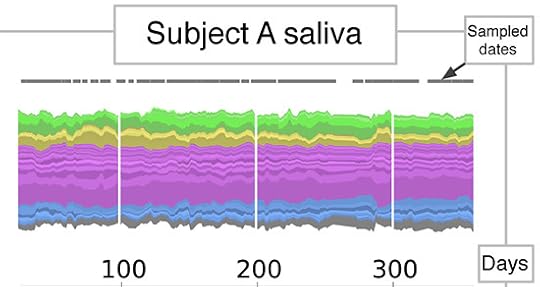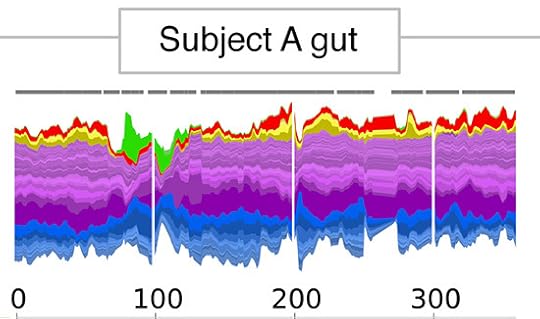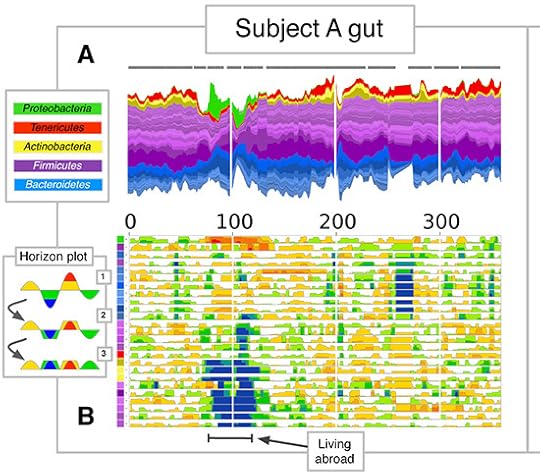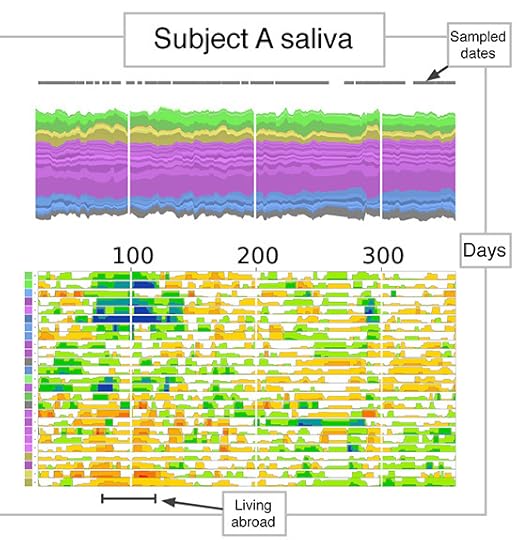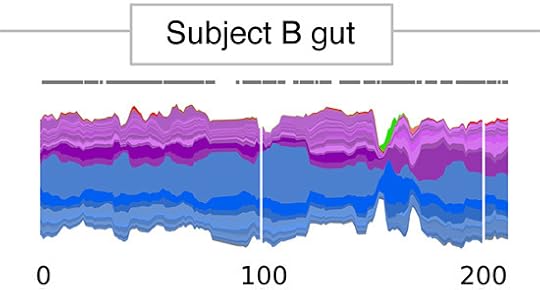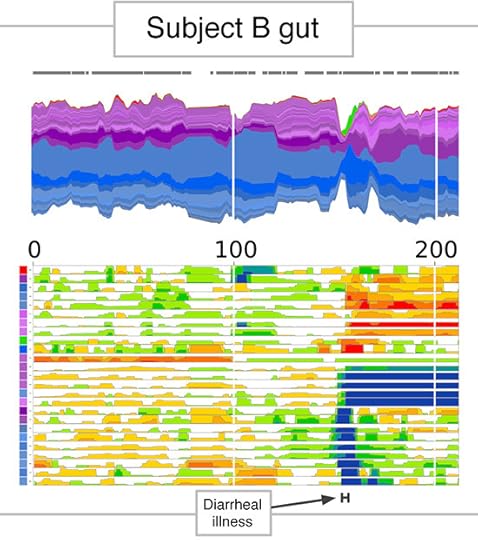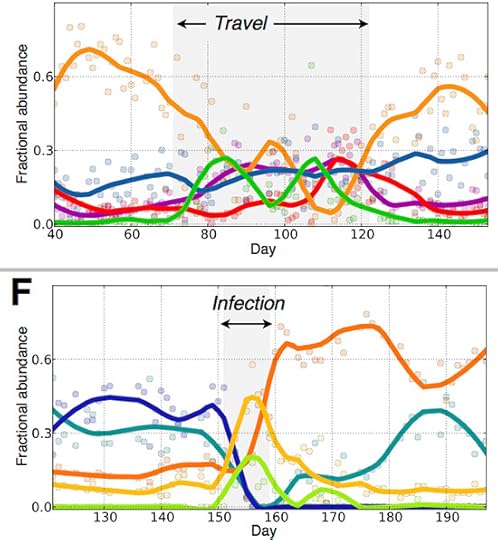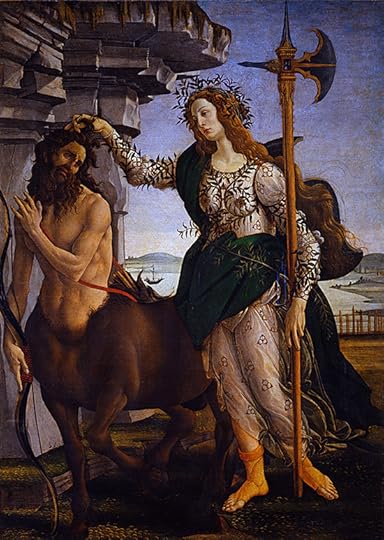Carl Zimmer's Blog, page 10
August 13, 2014
The Tree of Smells
Animals have been smelling for hundreds of millions of years, but the evolution of that sense is difficult to trace. You can’t ask an elephant to describe the fragrance of an acacia tree, for example, nor can you ask a lion if it gets the same feeling from a whiff of the same plant.
So scientists have to gather indirect clues to how different species use their noses. One way is to run simple tests on animals, seeing if they show an ability to tell different odors apart. Elephants, for example, can tell the difference between the smells of as many as 30 different members of their extended family.
Another way to track the evolution of smelling is to dissect the molecules that do the smelling in different species. Inside our noses, nerve endings are studded with receptors that can grab different odor molecules. All mammals build variations on the same basic structure, known as an olfactory receptor. But they may have hundreds of different kinds of receptors in their noses, each encoded by a different gene. The structure of each kind of receptor determines the kind of molecules it can grab–and the signal it can send to the brain.
Recently, scientists at the University of Tokyo compared 20,000 olfactory receptor genes from 13 species of mammals. In some cases, such as elephants, they were the first to make such a catalog. In other cases, such as cows and mice, they identified olfactory receptor genes that had gone overlooked till now.
One striking result of the study was that elephants have a lot of different olfactory receptors. They have 1948 receptor genes, the highest ever recorded for a species. Dogs have less than half, with 811. And humans have 396.
Does that mean that elephants have evolved to become five times better at smelling than we are? There’s not a simple relationship between olfactory receptor genes and the sense of smell. And the evolution of smell is a lot more than just a list of numbers.
New olfactory receptors don’t just come out of the blue. They emerge from a special kind of mutation. Sometimes when cells are duplicating their genes, they accidentally make an extra copy of a stretch of DNA. Where there was once a single olfactory receptor gene, there are now two identical copies. Mutations can then alter the sequence of one of the genes, and thus change the structure of the receptor.
But mutations can also rob mammals of olfactory receptors. They can disable a gene, so that neurons can’t use it to make the corresponding receptor. In some cases, they accidentally delete the gene altogether.
What’s most interesting about the new study from Tokyo is that the scientists were able to reconstruct 100 million years of smell evolution in a single tree. They could recognize related versions of the same gene in different species, and use that information to trace when new genes arose and when they disappeared.
Here’s the tree, and I’ll explain it below.

Niiumura et al http://genome.cshlp.org/content/early...
The common ancestor of all these species lived about 100 million years ago. Based on their shared genes, the scientists determined that that ancestral mammal had 781 genes–almost twice as many as we have today, and less than half of what elephants have.
The blue circles show how many genes the common ancestors of today’s mammals had at each node in the tree. The numbers along each of the branches show how many new genes were gained, and how many were lost.
The lineage that led to elephants certainly gained a lot of new genes–1335 all told. But so did a lot of other lineages. If you trace the tree from the base to rats, you’ll find that they gained 884 new genes. But they also lost a lot of genes along the way, too, so that now they have only 1207 genes.
But elephants lost genes, too–168 all told. Even if elephants do have an amazing sense of smell (something we just don’t know), that wasn’t simply the result of adding new genes. Some genes may have been useless to them–ones that remain useful in other species. But we don’t know why they lost the genes they did.
There are other weird features of this tree. As you move down the tree from the common ancestor to rats, for example, you can see that their ancestors had a net gain of genes for their first 10 million years or so, followed by at least 20 million years of losses, followed in turn by a major gain of genes. No one can say why they had these ups and downs.
Our own evolutionary story has mysteries of its own. There’s no question that we humans are pathetic in the olfactory receptor gene department. Many scientists have speculated that our primate ancestors shifted to relying more on vision for finding food and attracting mates. With a gain of vision came a loss of smell, the argument goes. But we can’t go too far in dismissing smell from our evolution. After all, as my fellow Phenom Ed Yong wrote this spring, we can still smell trillions of different smells. For some reason, other apes and monkeys have ended up with fewer olfactory receptor genes than we still have. It’s especially intriguing to consider all the genes we gained even as our collection of receptors shrank. We have 18 kinds of olfactory receptors that are found in no other mammals, not even chimpanzees, our closest living relatives. What on Earth do we use them for?
This tree represents everything we know about the evolution of these genes in mammals. But there are some 5000 other species of mammals on Earth, and adding their branches would reveal a lot more. As you can see in this figure, elephants are only distantly related to rodents, primates and the other species that have been studied so far. As a result, they sit on a long lonely branch in this tree. In reality, elephants have plenty of living relatives, such as manatees and hyraxes. It would be interesting to see if their huge set of genes grew gradually, or exploded after they gained their trunks.
Meanwhile, our own stubby branch raises questions of its own. Did Neanderthals have the identical set of olfactory receptor genes as we do? How would a rose smell to a Neanderthal, I wonder?
August 6, 2014
The Quantified Microbiome Self
Some of my friends are sporting wristbands these days that keep track of their bodies. Little computers nestled in these device inside record the steps they take each day, the beats of their heart, the length of their slumbers. At the end of each day, they can sit down at a computer and look at their data arrayed across a screen like a seismogram of flesh.
I got one of these devices as a gift recently. But as much as I enjoy wasting time with technology, I just didn’t care enough to put it on my wrist. I already know that I should run more, walk more, stand more, and avoid sitting in front of monitors more. I don’t need granular data to remind me of that.
But as I read the journal Genome Biology today, I decided that someday I might surrender to the Quantified Self movement. I’ll just have to wait till I can track my trillions of microbes from one day to the next.
Thanks to the falling cost of sequencing DNA, it’s now possible for us to survey the thousands of species that live in our bodies. A couple years ago, for example, I found out that I have 58 species in my bellybutton. But all I knew was that there were 58 species in my bellybutton at one point in time–that moment I swiped a Q-tip around my navel. But everything we know about bacteria tells us that our inner ecosystems can change swiftly. My bellybutton may be remarkably different today than it was when I put a Q-tip in it.
Eric Alm, a biologist at MIT, and a graduate student of his named Lawrence David decided to plumb this change by tracking a year in the life of their microbiomes. Each day, they saved some of their stool, and later, they extracted DNA from it to figure out which species of bacteria were living in their guts. David also spat some of his saliva into a tube each day so that he could compare how his microbiome changed in his gut compared to his mouth.
Even though their study only involved two people, it was still very much a Big Data project. And one of the major challenges of any Big Data project is to visualize the results in a useful way. A number on a wrist watch won’t cut it. Between Alm and David, they and their colleagues identified thousands of species of microbes. Most were rare, while a few hundred made up the majority of bugs in their bodies. Some species showed up briefly and vanished; others lingered all year.
Here’s one way to look at their microbiomes. It shows David’s saliva. Each band represents one of the dominant species (or operational taxonomic units). Species belonging to the same lineage (a phylum) have different shades of the same color.
It’s pretty stable over time, but shows some interesting flickers.
Now here’s David’s gut. A different set of species, and more turbulent from time to time, especially around day 100.
Something’s going on. One way to see what’s happening is to look at the microbiome in a different way. The lower figure shows the changes in each species, with drops in blue and rises in red. As you can see, some species became scarce about a third of the way into the experiment and then returned later. Likewise, other species flourished at the same time and then faded away.
It just so happens that this was when David went to Bangkok for a few weeks, where he had a couple bouts of diarrhea. (He kept a mini-fridge with him in Thailand where he could chill his stool.)
There’s a similar story in his mouth–although it involves different species that are adapted to the conditions there.
Now here’s Alm (he didn’t manage to go the whole year). The first thing you’ll notice is that Alm and David are microbially different. Over the year, they are consistently home to different kinds of bacteria.
A startling pinch occurs around day 150. There’s a story behind that. On an unlucky visit to a restaurant, Alm got food poisoning–Salmonella to be specific. In fact, Alm was able to diagnose himself through his experiment even when his doctor was assuring him he had a virus. The infection was so intense that on one day, Salmonella made up 29.5% of all the DNA fragments he discovered in his stool. Fortunately, his food poisoning wasn’t bad enough to require antibiotics.
In the more detailed graph below, you can see that even after Salmonella vanished from his gut, his microbiome remained different.
Looking at their microbiomes as just isolated species only took Alm and David so far, though. In reality, our microbes exist in communities. They may be adapted to the same acidity and other conditions, or they may depend on each other for survival.
Alm, David, and their colleagues found a way to visualize these communities as well. They identified five clusters of species whose changes tracked closely together. Here’s a chart of the changes they underwent, with David in the top graph and Alm in the lower one.
It appears that David’s microbiome switched from one state to another on his trip, and then back again. Alm’s microbes had a different experience. His food poisoning disrupted his microbiome, allowing a different combination of species to become dominant. It pushed him into a different state–a healthy one–and he’s now stuck there.
Alm, David, and their colleagues also tracked many other features of their lives during the study, from their meals to their moods. But aside from David’s trip to Bangkok and Alm’s bad dinner, they found little correlation between their experiences and their biodiversity. The only other factor that stood out was when David ate fiber-rich food–certain species of bacteria thrived the day after those meals.
It’s not possible to draw broad lessons from a two-person experiment. And it’s hard to imagine how it will become much bigger any time soon–who among us is ready to store stool away every day for a year? Perhaps someday someone will invent a lab-on-a-chip that you can swallow, and it swim in your gut, quietly monitoring your microbiome. At that point, I for one would happily track my inner zoo.
July 31, 2014
Hot Flies and Mosaic Parents
In the past couple weeks, I’ve been checking back in with a couple of my favorite lines of scientific research in my New York Times column.
–Last week, I wrote about how life will (or won’t) adapt to climate change. A new experiment suggests that some species may have more potential to evolve resistance to the new donations than previously thought. But we don’t know if that will be enough.
This is just one way in which we humans are now driving evolution in new directions. Here’s a video of a lecture I gave on the subject a few months ago at Harvard’s Arnold Arboretum:
–This week I take a look at the ever-fascinating subject of mosaics. We tend to think of ourselves as each having a single, unique genome. But we contain multitudes.
I wrote a feature for the New York Times about mosaics last September, pointing out how hard it can be to determine just how common and how important mosaicism is. In my latest column, I write about a new study that attempts to do just that, looking for mosaic parents who have unknowingly passed down harmful mutations to their children. It turns out to be more common than scientists had expected. Check it out.
July 22, 2014
Searching for the Genetic Roots of Mental Illness
In today’s New York Times, Benedict Carey and I have a feature about two big pieces of news on the search for genes involved in psychiatric diseases. After many years of struggle, a new paper published today shows how scientists are starting to build a catalog of these genes–in this case, over 100 genes associated with schizophrenia. The paper coincides with the other big piece of news we report on: the announcement of a $650 million gift to the Broad Institute (one of the partners in the new study) from a family that has been personally affected by psychiatric diseases–the biggest gift for psychiatric research ever.
There are lots of issues at play here. For one thing, it speaks to the rise in private funding of scientific research, a topic explored in depth in this Times feature by William Broad. Will all this private money enable the Broad team to do research that they wouldn’t be able to if they had to apply for round after round of funding from government sources?
Another issue is the importance of genetics in psychiatric diseases. Just because there are genes involved in schizophrenia doesn’t mean it’s simply a genetic disorder like sickle cell anemia. What these findings suggest is that some mutations to some genes may make some people at greater risk for schizophrenia than others–perhaps, for example, because it raises the risk that an infection sets off an immune response that harms the brain (that’s one theory). But similar studies on depression haven’t yielded strong results–is that because genetics doesn’t make much difference to who gets depressed or who doesn’t? Or do we just need to look at more people?
In any case, I hope our story helps inform discussions on these issues. Check it out.
July 18, 2014
Can We Forecast Evolution?
Evolution is complex–does that mean it’s too complex to predict? Biologists used to leave the question to philosophers (or to philosophically-minded biologists). But in a new feature for Quanta, I look at cases where evolution is indeed predictable–including some upon which lives depend, such as the evolution of the flu and cancer.
July 17, 2014
Can We Genetically Engineer the Wilderness? Should We?
There’s a new way to edit DNA. It’s called CRISPR, and it’s taking science by storm. Its versatility and speed have led scientists to explore all sorts of uses for it. One of the most radical ideas--proposed today in a pair of papers–is to use it to alter the DNA of species we want to get rid of. Think of malaria-bearing mosquitoes, bat-killing fungi, and the like. It’s a provocative idea, but does it threaten to do more harm than good? I take a look at the issue in my new “Matter” column for the New York Times. Check it out.
July 15, 2014
Why Do We Have Blood Types?
Knowing your blood types can be a matter of life and death. So you might think that scientists had a clear idea of why we have them in the first place. I’ve written a feature for Mosaic, a new online magazine about medicine, in which I try to get the answer. It proves a lot harder than I expected. Check it out.
July 14, 2014
The Old Old Earth
In 1517, the Republic of Venice rebuilt the fortifications protecting the city of Verona. During the construction, strange rocks came to light, looking eerily like seashells and crabs. People had long puzzled over fossils, but for some reason this new discovery left the people of Verona especially intrigued. Perhaps it was the fact that crabs and seashells live in the ocean, which was sixty miles from the city.

View of Verona with the Castelvecchio and Ponte Scaligero Bernardo Bellotto, Italian. Philadelphia Museum of Art. http://www.philamuseum.org/collection...
Some Veronese citizens decided to bring the rocks to the most learned scholar in the city at the time: a physician named Girolamo Fracastoro. Fracastoro looked at the fossils and came to a surprising conclusion. He immediately ruled out the possibility that Noah’s Flood could have delivered the sea creatures to Verona. Instead, Fracastoro declared that fossils had come to the city through a series of gradual changes to an immensely old Earth.
Fracastoro explained that over vast cycles, the ocean slowly moved inland and then slowly crept back out. It would flood one country as it retreated from another. Over time, great volumes of sand and debris accumulated on the sea floor, and when the ocean ebbed it left behind hills and mountains–complete with the fossils of sea creatures.
Five centuries later, it can be hard to believe that anyone in Fracostoro’s time could have such an appreciation for the great age of the Earth. It’s only in the modern age of science that we know that the Earth is indeed enormously old–over 4.6 billion years old, in fact–and that its surface has been gradually worked over that vast stretch of time. Before the rise of modern science, we assume, Europeans relied on a strict reading of the Bible to explain the history of the Earth and believed that the planet was just a few thousand years old. Today, young Earth creationists seem like vestiges left behind from that pre-modern age.
And yet there’s no doubt that Fracostoro appreciated Deep Time. He may not have understood radiometric dating, but he certainly didn’t think the world was a few thousand years old.
To fit Fracostoro into conventional narratives, historians have tried to cast him as a fluke. They acknowledge that a few early scholars believed in an ancient Earth. But they were ignored because they were too far ahead of their time. It wasn’t until the 1700s that science had matured enough for an ancient age of the Earth to be widely accepted.
That story may feel satisfying, but it doesn’t fit the facts. In a June issue of the journal Isis the Yale historian Ivano Dal Prete argues Fracostoro was very much of his time.
When Fracostoro described the gradual changes to the Earth, he didn’t claim that he was saying anything new or controversial. Instead, he relied on centuries of previous writers. In the Middle Ages, European scholars had rediscovered Aristotle, who had written that the same part of the Earth that are now dry were once wet, and vice versa. In the 1200s and 1300s, philosophers built on Aristotle’s work with more complicated explanations for the Earth’s history. “The earth has always existed as Aristotle appears to have thought,” wrote Jean Buridan in the early 1300s, “even though this may not be true according to our faith.” In the late 1400s, another writer noted that the view of Earth as undergoing gradual changes over vast stretches of time was the “most common among philosophers.”
By the early 1500s, Dal Prete writes, it wasn’t just philosophers who shared this view. So did the reading public. Earth sciences became so popular that publishers cranked out a torrent of books on the topic. Rather than scholarly Latin, these books appeared in Italian and other vernacular language. In those books, the public could be exposed to the idea of an ancient Earth.
Even cardinals jumped on the band wagon. Gasparo Contarini, a cardinal from Venice in the early 1500s, published an entire book about geology. And he did so without ever once mentioning Noah’s Flood. Instead, Contarini wrote that physical forces sculpted the planet over vast stretches of time.

Apparition of the Virgin to St Bernard, by Filippino Lippi, 1480. Source: http://commons.wikimedia.org/wiki/Fil...
You don’t have to page through old books to see just how geologically minded people in the Renaissance had become. Their paintings show us where their eyes turned when they looked at landscapes. And remarkably often, they turned to rocks. A number of the finest painters of the Renaissance incorporated exposed layers of rocks in their pictures–the fruits of careful observation. They were looking at the intricate effects of millions of years of geological change.
It’s always a mistake to impose a simple science-versus-religion structure onto the history of thought, and Dal Prete shows that geology is no exception. In 1519, for example, a writer named Tiberio Russilano got in trouble for a book called Apology against the Hooded, in which he dismissed the Biblical history of the Earth and argued that the planet was immensely old. The Inquisition burned the book, and Russilano barely escaped arrest.
It would be easy to jump to the conclusion that he got in trouble for his science. But the history is more complicated than that. The book was actually grab bag of all sorts of strange passages–both scientific and theological. And it was the theological material, such as Russilano’s denial that Christ was divine, that really riled up the inquisitors.
That’s not to say that religion didn’t have an effect on the history of science. By the late 1500s, Protestantism was on the rise across Europe, and the Catholic Church responded with the Counter-Reformation. Part of that effort included putting pressure on publishers. They demanded that the Bible be read as literal history unless there was irrefutable proof for a different reading. “The world is not eternal,” declared the Jesuit priest Benito Pereira in the 1570s. “From its beginning to those days no more than five thousand six hundred years have elapsed.”
It turns out, however, that many philosophers didn’t follow Pereira example very closely. They accepted that the Earth had not existed forever, but they saw it as lasting far longer than a few thousand years. Some treated Noah’s Flood as a real geological event, but merely as the most recent of many great cataclysms. And for all the vigor of the Counter-Reformation, no one was burned at the stake for such claims.
Writers in Italy and elsewhere continued to develop ideas about the history of Earth. They investigated fossils more deeply, they thought long and hard about how layers of rock formed, and they considered how volcanoes and earthquakes shaped the planet. By the 1700s, the outlines of modern geology were emerging. But the proto-geologists of the 1700s didn’t see their work as a fundamental break from the past. Instead, they saw a seamless connection reaching back centuries.
July 9, 2014
Helping the Frogs Help Themselves Out of Extinction
Frogs and other amphibians are under attack from a fungus. First observed some two decades ago, the fungus has swept the world and has been implicated in the extinctions of hundreds of species. Yet it’s really only been in the past few years that scientists have started to get a handle on how it makes frogs sick and kills them. In my “Matter” column this week in the New York Times, I take a look at an experiment that offers a glimmer of hope. If frogs don’t get killed by the fungus, they develop some defenses against later infections.
It’s conceivable that someday scientists might, in effect, vaccinate amphibians against the fungus, allowing enough of them to withstand the pathogen to keep their species going. It may feel odd for us to become wildlife’s veterinarian, but in some cases that may be the only the way we can stop species from vanishing. Bats, for example, are getting hammered by another species of fungus. Perhaps someday biologists will spray dead fungal spores into caves to give bats a fighting chance. Perhaps. To see where we stand right now, check out the column.
July 7, 2014
Ask the Author (in this case, me)
For more details on "Ask the Author," you can check out this FAQ.

